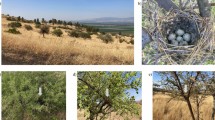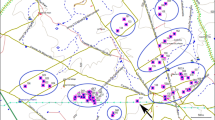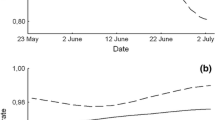Abstract
The main purpose of this study was to provide exhaustive and extensive data on the breeding biology of the Mediterranean Tawny Pipit Anthus campestris. Reproduction was studied within two populations nesting in shrubsteppes in central Spain. We compared breeding parameters (including hatching success, productivity, incubation, brood failures, predation rates, clutch and brood size) between study areas, and among years within each area. Our results suggest that Tawny Pipit reproduction in Spanish shrubsteppes is influenced by two main related factors: timing of breeding and nest predation. We detected seasonal declines in most breeding parameters, but a mid-season peak in productivity. Although large-sized broods were detected at the beginning of the breeding season, the recruitment of these juveniles was very low due to high predation rates on early broods. Finally, our results are compared with the scarce available data from previous breeding studies from other European Tawny Pipit populations.
Zusammenfassung
Brutleistung und Nestprädationsmuster bei steppegebundenen Vögeln des Mittelmeerraums: der Fall des Brachpiepers Anthus campestris
Der Hauptzweck dieser Studie war es, vollständige und umfassende Daten zur Brutbiologie mediterraner Brachpieper Anthus campestris bereitzustellen. Die Fortpflanzung wurde in zwei Populationen, die in Strauchsteppe in Zentralspanien nisten, untersucht. Wir haben Brutparameter (einschließlich Schlupferfolg, Produktivität, Bebrütung, Brutverluste, Prädationsraten, Gelege- und Brutgrößen) zwischen den Untersuchungsgebieten sowie innerhalb der Untersuchungsgebiete zwischen verschienenden Jahren verglichen. Unsere Ergebnisse deuten darauf hin, dass die Fortpflanzung von Brachpiepern in spanischen Strauchsteppen von zwei Hauptfaktoren beeinflusst wird: Zeitpunkt des Brütens und Nestprädation. Wir haben ermittelt, dass die meisten Brutparameter im Verlauf der Saison abnahmen, die Produktivität jedoch in der Mitte der Saison ihren Höhepunkt erreichte. Obwohl zu Beginn der Brutsaison große Bruten erfasst wurden, waren die Rekrutierungsraten für diese Jungvögel sehr niedrig, da frühe Bruten einem hohen Prädationsrisiko ausgesetzt waren. Schließlich vergleichen wir unsere Ergebnisse mit den wenigen verfügbaren Daten aus früheren Brutstudien in anderen europäischen Brachpieperpopulationen.





Similar content being viewed by others
References
Alström P, Mild K (2003) Pipits and Wagtails of Europe, Asia and North America: identification and systematics. Christopher Helm, London
Ashmole N (1961) The biology of certain terms. PhD dissertation. Oxford University, Oxford
Bautista LM, Pantoja JC (2000) A bibliometric review of the recent literature in ornithology. Ardeola 47:109–121
Bijlsma RG (1978) Het voorkomen van de Duinpieper Anthus campestris op de Zuidwest-Veluwe, Nederland, deel 1: broedtijd. Limosa 51:107–121
BirdLife International and NatureServe (2011) Bird species distribution maps of the world. BirdLife International/NatureServe, Cambridge/Arlington
BirdLife-International (2004) Species factsheet: Anthus campestris. http://www.birdlife.org
BirdLife-International (2010) Species factsheet: Anthus campestris. http://www.birdlife.org
Blondel J, Dervieux A, Maistre M, Perret P (1991) Feeding ecology and life history variation of the blue tit in Mediterranean deciduous and sclerophyllous habitats. Oecologia 88:9–14
Blondel J, Aronson J, Bodiou JY, Boeuf G (2010) The Mediterranean region: biological diversity in space and time. Oxford University Press, Oxford
Brambilla M, Rubolini D (2005) Caratteristiche macroambientali dell’habitat riproduttivo del calandro Anthus campestris. Avoceta 29:105
Calero-Riestra M, García J, Suárez F (2010) ¿Dobles puestas o reposiciones? El caso del bisbita campestre Anthus campestris. Paper presented at the XX Congreso Español de Ornitología, Tremp
Carrascal LM, Palomino D (2008) Las aves comunes reproductoras en España. Población en 2004–2006. SEO/Birdlife, Madrid
Cramp S (ed) (1998) The Birds of the Western Palearctic, vol 5. Oxford University Press, Oxford
Crick HQP (2004) The impact of climate change on birds. Ibis 146:48–56
Crick H, Gibbons D, Magrath R (1993) Seasonal changes in clutch size in British birds. J Anim Ecol 62:263–273
Davis SK (2009) Renesting intervals and duration of the incubation and nestling periods of Sprague’s Pipits. J Field Ornithol 80:265–269
Del Hoyo J, Elliott A, Christie D (eds) (2004) Handbook of the birds of the world (volume 9): Cotingas to Pipits and Wagtails. Del Hoyo J, Elliott A, Sargatal J (eds) 1992. Handbook of the birds of the world, vol 1. Lynx, Barcelona
Donald PF, Green RE, Heath MF (2001) Agricultural intensification and the collapse of Europe’s farmland bird populations. Proc R Soc Lond B 268:25–29
Dunn P (2004) Breeding dates and reproductive performance. Adv Ecol Rs 35:69–87
Evans DM, Redpath SM, Evans SA (2005) Seasonal patterns in the productivity of Meadow Pipits in the uplands of Scotland. J Field Ornithol 76:245–251
Gordo O, Sanz J (2005) Phenology and climate change: a long-term study in a Mediterranean locality. Oecologia 146:484–495
Götmark F (1992) The effects of investigator disturbance on nesting birds. Curr Ornithol 9:63–104
Grant TA, Shaffer TL, Madden EM, Pietz PJ, Johnson D (2005) Time-specific variation in passerine nest survival: new insights into old questions. Auk 122:661–672
Grzybek J, Michalak I, Osiejuk TS, Tryjanowski P (2008) Densities and habitats of the Tawny Pipit Anthus campestris in the Wielkopolska region (W Poland). Acta Ornithol 43:221–225
Högstedt G (1978) Orientation of the entrance in Tawny Pipit Anthus campestris nests. Ornis Scand 9:193–196
Jacobson MD, Tsakiris ET, Long AM, Jensen WE (2011) No evidence for observer effects on Lark Sparrow nest survival. J Field Ornithol 82:184–192
Johnson D (1979) Estimating nest success: the Mayfield method and an alternative. Auk 96:651–661
Krüger S (1989) Der Brachierper Anthus campestris., vol 598. Ziemsen, Wittenberg Lutherstadt
Lack D (1947) The significance of clutch-size. Ibis 89:302–352
Lack D (1950) The breeding seasons of European birds. Ibis 92:288–316
Lack D (1968) Ecological adaptations for breeding in birds. Methuen, London
Lloyd P, Little RM, Crowe TM (2000) Investigator effects on the nesting success of arid-zone birds. J Field Ornithol 71:227–235
Magnhagen C (1991) Predation risk as a cost of reproduction. Trends Ecol Evol 6:183–186
Major RE (1990) The effect of human observers on the intensity of nest predation. Ibis 132:608–612
Mallord J, Dolman P, Brown A, Sutherland W (2008) Early nesting does not result in greater productivity in the multi-brooded Woodlark Lullula arborea. Bird Study 55:145–151
Martin T (1987) Food as a limit on breeding birds: a life-history perspective. Annu Rev Ecol Syst 18:453–487
Martin TE (1993) Nest predation among vegetation layers and habitat types: revising the dogmas. Am Nat 141:897–913
Martin TE, Geupel GR (1993) Nest-monitoring plots: methods for locating nests and monitoring success. J Field Ornithol 64:507–519
Martin TE, Scott J, Menge C (2000) Nest predation increases with parental activity: separating nest site and parental activity effects. Proc R Soc Lond B 267:2287–2293
Mayfield H (1961) Nesting success calculated from exposure. Wilson Bull 73:255–261
Mayfield H (1975) Suggestions for calculating nest success. Wilson Bull 87:456–466
Moreno J (2004) Avian reproduction in a Mediterranean context: contributions of ornithological research in Spain. Ardeola 51:51–70
Osiejuk TS, Grzybek J, Tryjanowski P (2007) Song structure and repertoire sharing in the Tawny Pipit Anthus campestris in Poland. Acta Ornithol 42:157–165
Peinado M, Rivas-Martínez S (1987) La vegetación de España., vol 3. Colección Aula Abierta. Servicio de Publicaciones de la Universidad de Alcalá, Alcalá de Henares
Perrins C (1970) The timing of birds’ breeding seasons. Ibis 112:242–255
Ricklefs RE (1969) An analysis of nesting mortality in birds, vol 9. Smithsonian contributions to zoology. Smithsonian Institution Press, Washington
Sanz JJ (1997) Geographic variation in breeding parameters of the Pied Flycatcher Ficedula hypoleuca. Ibis 139:107–114
Schielzeth H (2010) Simple means to improve the interpretability of regression coefficients. Method Ecol Evol 1:103–113
Shaffer T (2004) A unified approach to analyzing nest success. Auk 121:526–540
Skutch AF (1949) Do tropical birds rear as many young as they can nourish. Ibis 91:430
Slagsvold T (1982) Clutch size variation in passerine birds: the nest predation hypothesis. Oecologia 54:159–169
Stamou GP, Stamou GV, Papatheodorou EM, Argyropoulou MD, Tzafestas SG (2004) Population dynamics and life history tactics of arthropods from Mediterranean-type ecosystems. Oikos 104:98–108
StatSoft (2007) STATISTICA (data analysis software system), version 8.0. Statsoft, Tulsa
Suárez F, Manrique J (1992) Low breeding success in Mediterranean shrubsteppe passerines: thekla lark Galerida theklae, lesser short-toed lark Calandrella rufescens, and black-eared wheatear Oenanthe hispanica. Ornis Scand 23:24–28
Suárez F, Yanes M, Herranz J, Manrique J (1993) Nature reserves and the conservation of Iberian shrubsteppe passerines: the paradox of nest predation. Biol Conserv 64:77–81
Suárez F, Morales MB, Minguez I, Herranz J (2005a) Seasonal variation in nest mass and dimensions in an open-cup ground-nesting shrub-steppe passerine: the Tawny Pipit Anthus campestris. Ardeola 52:43–51
Suárez F, Traba J, Herranz J (2005b) Body mass changes in female Tawny Pipits Anthus campestris during the nesting stage. J Ornithol 146:372–376
Suárez F, Herranz J, Yanes M, Sánchez AM, García JT, Manrique J (2005c) Variación estacional e interanual en la reproducción de cuatro alondras en Espana mediterránea: fecha y tamano de puesta, tamano de los huevos y asincronía de puesta. Ardeola 52:103–117
Sutherland WJ, Newton I, Green R (eds) (2004a) Bird ecology and conservation: a handbook of techniques. Oxford University Press, Oxford
Sutherland WJ, Pullin AS, Dolman PM, Knight TM (2004b) The need for evidence-based conservation. Trends Ecol Evol 19:305–308
Svensson L (ed) (1992) Identification guide to European Passerines, 4th edn. British Trust for Ornithology, Stockholm
Svensson E (1995) Avian reproductive timing: when should parents be prudent? Anim Behav 49:1569–1575
Tryjanowski P, Kuźniak S (1999) Effect of research activity on the success of Red-backed Shrike Lanius collurio nests. Ornis Fenn 76:41–43
Tyler SJ (2004) Family Motacillidae (pipits and wagtails). In: Del Hoyo J, Elliott A, Christie D (eds) Handbook of the birds of the world (volume 9): Cotingas to Pipits and Wagtails. Lynx, Barcelona, pp 686–786
Van Turnhout C (2005) The disappearance of the Tawny Pipit Anthus campestris as a breeding bird from The Netherlands and Northwest-Europe. Limosa 78:1–14
Weatherhead PJ, Blouin-Demers G, Cavey KM (2003) Seasonal and prey-size dietary patterns of black ratsnakes (Elaphe obsoleta obsoleta). Am Midl Nat 150:275–281
Weidinger K (2008) Nest monitoring does not increase nest predation in open-nesting songbirds: inference from continuous nest-survival data. Auk 125:859–868
Wright L, Hoblyn R, Green R, Bowden C, Mallord J, Sutherland W, Dolman P (2009) Importance of climatic and environmental change in the demography of a multi-brooded passerine, the woodlark Lullula arborea. J Anim Ecol 78:1191–1202
Yanes M, Suárez F (1995) Nest predation patterns in ground-nesting passerines on the Iberian Peninsula. Ecography 18:423–428
Yanes M, Suárez F (1996) Incidental nest predation and lark conservation in an Iberian semiarid shrubsteppe. Conserv Biol 10:881–887
Acknowledgments
This study was funded by JCCM projects (PAC06-0137 and PII1C09-0128-4724) and CSIC-MICINN project (PIE 201030I019). M.C.-R. was supported by a predoctoral grant (I3P) from the Consejo Superior de Investigaciones Científicas (CSIC). We are grateful to the Junta de Comunidades de Castilla-La Mancha for capture licenses, the landowners of Layna and Valeria, I. Hervás and J. Hernández-Justribó for their help during the fieldwork. A. Benitez, B. Frasure and Sally Bach checked the language in different versions of the manuscript. This paper is dedicated to the memory of our beloved colleague F. Suárez (“Quico”).
Author information
Authors and Affiliations
Corresponding author
Additional information
Communicated by P. H. Becker.
Rights and permissions
About this article
Cite this article
Calero-Riestra, M., García, J.T., Herranz, J. et al. Breeding output and nest predation patterns in steppe-associated Mediterranean birds: the case of the Tawny Pipit Anthus campestris . J Ornithol 154, 289–298 (2013). https://doi.org/10.1007/s10336-012-0893-4
Received:
Revised:
Accepted:
Published:
Issue Date:
DOI: https://doi.org/10.1007/s10336-012-0893-4




